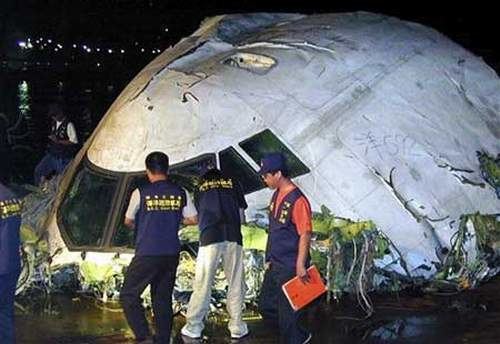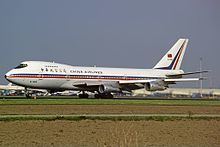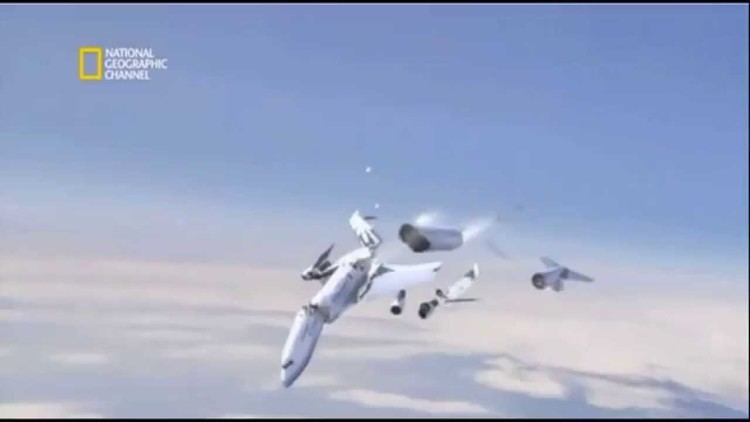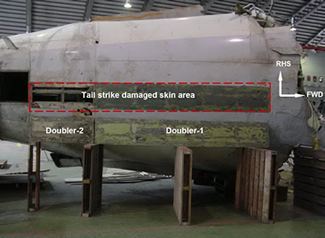Passengers 206 Date 25 May 2002 Total fatalities 225 (all) Passenger count 206 | Survivors 0 Registration B-18255 Survivor 0 Crew count 19 | |
 | ||
Similar Überlingen mid‑air collision, China Airlines Flight 006, Flash Airlines Flight 604, United Airlines Flight 585, Adam Air Flight 574 | ||
Air crash investigations mayday 07x01 scratching the surface china airlines flight 611
China Airlines Flight 611 was a regularly scheduled passenger flight from the former Chiang Kai-shek International Airport (now Taiwan Taoyuan International Airport) in Taiwan to Hong Kong International Airport in Hong Kong. On 25 May 2002, the Boeing 747-209B operating the route disintegrated in mid-air due to faulty repairs and crashed into the Taiwan Strait 23 nautical miles (43 km) northeast of the Penghu Islands 20 minutes after takeoff, killing all 225 people on board. The in-flight break-up was caused by improper repairs to the aircraft 22 years earlier. As of January 2016, it remains the most recent accident involving a Boeing 747 to result in passenger fatalities, the deadliest accident in Taiwanese history, and the deadliest since the loss of American Airlines Flight 587 in 2001, until the loss of Air France Flight 447 (an Airbus A330) in 2009.
Contents
- Air crash investigations mayday 07x01 scratching the surface china airlines flight 611
- Flight and disaster
- Passengers
- Recovery and identification of remains
- Search recovery and investigation
- Metal fatigue
- Aircraft history
- Aftermath
- Dramatization
- References

The accident was particularly disturbing to the public as the Taipei–Hong Kong route was and still is one of the most heavily traveled air routes in the world; it is so profitable that it is even referred to as the "Golden Route".

Flight and disaster

The flight took off at 15:08 local time (07:08 UTC) and was scheduled to arrive at Hong Kong at 16:28 HKT (08:28 UTC). The flight crew consisted of 51-year-old Captain Ching-Fong Yi (易清豐; I Cingfong}), 52-year-old First Officer Yea Shyong Shieh (謝亞雄; Syieh Yasyong), and 54-year-old Flight Engineer Sen Kuo Chao (趙盛國; Jhao Shengkuo). The names of the pilot and first officer, respectively, are alternatively romanized as "Yi Ching-Fung" and "Hsieh Ya-Shiung". All three pilots were highly experienced airmen – the captain and first officer each had more than 10,100 hours of flying time and the flight engineer had clocked more than 19,100 flight hours.

At 15:16, the flight was cleared to climb to flight level 350 (approximately 35,000 feet (11,000 m)). At 15:33, contact with the plane was lost.

Chang Chia-juch, the Taiwanese Vice Minister of Transportation and Communications, said that two Cathay Pacific aircraft in the area received B-18255's emergency location-indicator signals. All 19 crew members and 206 passengers on board the aircraft died.
Passengers
The passengers included a former legislator and two reporters from the United Daily News. The majority of the passengers, 114 people, were members of a Taiwanese group tour to the mainland organized by four travel agencies. Almost all of the passengers were ethnic Chinese. The sole non-ethnic Chinese person was a Swiss man.
Recovery and identification of remains
Of the 225 passengers and crew on board, remains of 175 were recovered and identified. The first 82 bodies were found floating on the ocean surface of the Taiwan Strait and were recovered by fishing boats and military vessels. Contracted recovery vessels were subsequently utilized for the recovery of the aircraft wreckage and the remaining bodies.
Each body was assigned a recovery number issued in the order of its transport to the morgue. The victims were identified by visual identification, personal effects, fingerprints, dental examinations and through DNA testing. Only the three recovered flight crewmember bodies were autopsied. The victim’s bodies were photographed and their clothing and possessions were cataloged and returned to the victim’s families. The victims’ records, including body diagrams, injury protocols, photographs, and other documents related to the recovery and identification of the individuals were then correlated for each identified victim.
Most of the victims had extensive injuries consistent with head trauma, tibia and fibula fractures, significant back abrasions and pelvic injuries. Most of the bodies were nearly intact except, in some cases, for fractured bones. Some of the victims had expansion of lung tissue, subcutaneous emphysema, and bleeding on the nose and mouth. There were no carbon remains found on any of the recovered bodies or their clothes, and no sign of fire, burning or blast damage was found.
Search, recovery and investigation
At 17:05, a military C-130 aircraft spotted a crashed airliner 23 nautical miles (43 km) northeast of Magong, Penghu Islands. Oil slicks were also spotted at 17:05; the first body was found at 18:10.
Searchers recovered 15 percent of the wreckage, including part of the cockpit, and found no signs of burns, explosives or gunshots.
There was no distress signal or communication sent out prior to the crash. Radar data suggests that the aircraft broke into four pieces while at FL350. This theory is supported by the fact that articles that would have been found inside the aircraft were found up to 80 miles (130 km) from the crash site in villages in central Taiwan. The items included magazines, documents, luggage, photographs, Taiwan dollars, and a China Airlines-embossed, blood-stained pillow case.
The flight data recorder from Flight 611 shows that the plane began gaining altitude at a significantly faster rate in the 27 seconds before it broke apart, although the extra gain in altitude was well within the plane's design limits. The plane was supposed to be leveling off then as it approached its cruising altitude of 35,000 feet. Shortly before the breakup, one of the aircraft's four engines began providing slightly less thrust. Coincidentally, the engine was the only one recovered from the sea floor. Pieces of the aircraft were found in the ocean and on Taiwan, including in the city of Changhua.
The governments of Taiwan and the People's Republic of China co-operated in the recovery of the aircraft; the Chinese allowed personnel from Taiwan to search for bodies and aircraft fragments in those parts of the Taiwan Strait controlled by the People's Republic of China.
China Airlines requested relatives to submit blood samples for DNA testing at the Criminal Investigation Bureau of National Police Administration (now National Police Agency) and two other locations.
The United Daily News stated that some relatives of passengers described the existence of this flight to Hong Kong as being "unnecessary". Most of the passengers intended to arrive in Mainland China, but because of a lack of direct air links between Taiwan and Mainland China, the travellers had to fly via Hong Kong; the relatives advocated the opening of direct air links between Taiwan and Mainland China, which was eventually realized.
Metal fatigue
The final investigation report found that the accident was the result of metal fatigue caused by inadequate maintenance after a much earlier tailstrike incident. On 7 February 1980, the aircraft was flying from Stockholm Arlanda Airport to Taoyuan International Airport via King Abdulaziz International Airport and Kai Tak International Airport on China Airlines Flight 009. While landing in Hong Kong, part of the plane's tail had scraped along the runway. The aircraft was depressurized, ferried back to Taiwan on the same day, and a temporary repair done the day after. A more permanent repair was conducted by a team from China Airlines from 23 May through 26 May 1980. However, the permanent repair of the tail strike was not carried out in accordance with the Boeing Structural Repair Manual (SRM). According to the manual, repairs could be made by replacing the entire affected skin or by cutting out the damaged portion and installing a reinforcing doubler to restore the structural strength. These two acceptable options were set aside in favor of a third, improvised option, which entailed installing a doubler over the scratched skin. This external doubler did not effectively cover the damaged area in its entirety, as scratches were found at, and outside, the outer row of fasteners securing the doubler. The doubler having been installed with scratches remaining outside the rivets meant that there was no protection against the propagation of a concealed crack in the area between the rivets and the perimeter of the doubler.
Consequently, after repeated cycles of depressurization and pressurization during flight, the weakened hull gradually started to crack and finally broke open in mid-flight on 25 May 2002, coincidentally 22 years to the day after the faulty repair was made upon the damaged tail. An explosive decompression of the aircraft occurred once the crack opened up, causing the complete disintegration of the aircraft in mid-air. This was not the first time that a plane had crashed because of a faulty repair following a tailstrike. On 12 August 1985, 17 years before the Flight 611 crash and 7 years after the accident aircraft's repair, Japan Airlines Flight 123 had crashed when the vertical stabilizer was torn off and the hydraulic systems severed by explosive decompression, killing 520 of the 524 people on board. That crash had been attributed to a faulty repair to the rear pressure bulkhead, which had been damaged in 1978 in a tailstrike incident. In both crashes, a doubler plate was not installed according to Boeing standards.
China Airlines disputed much of the report, stating that investigators did not find the pieces of the aircraft that would prove the contents of the investigation report.
One piece of evidence of the metal fatigue is contained in pictures that were taken during a routine inspection of the plane years before the crash. The photos showed visible brown nicotine stains around the doubler plate. This nicotine was deposited by smoke from the cigarettes of passengers who were smoking through 1995, when the airline banned inflight smoking. The doubler plate had a brown nicotine stain all the way around it that could have been detected visually by any of the engineers when they inspected the plane. The stain would have suggested that there might be a crack caused by metal fatigue behind the doubler plate, as the nicotine slowly seeped out due to pressure that built up when the plane reached its cruising altitude. The stains were apparently not noticed and no correction was made to the doubler plate. Had an engineer taken notice of the stains, it is likely that the crash would never have happened.
Aircraft history
The aircraft involved, registration B-18255 (originally registered as B-1866), MSN 21843, was the only Boeing 747-200 passenger aircraft left in the China Airlines fleet at the time. It was delivered to the airline in 1979 and had logged 64,810 hours of flight time. The aircraft had a 274-seat configuration (22 first-class, 84 business-class, 131 main deck economy-class and 37 upper-deck economy seats). Prior to the crash, China Airlines had sold B-18255 to Orient Thai Airlines for US$1.45 million. The accident flight was the aircraft's penultimate flight for China Airlines as it was scheduled to be delivered to Orient Thai Airlines after its return flight from Hong Kong to Taipei. The contract to sell the aircraft was voided after the crash.
There were only three passenger 747-200s delivered to China Airlines, all from 1979-1980. The other two had been in full passenger service until 1999, when they were converted to freighters. They were immediately grounded by the ROC's Civil Aviation Administration (CAA) after the crash for maintenance checks.
One of the other 747s also crashed, years later: B-1886, sold to Kalitta Air and re-registered N714CK, operating on behalf of Centurion Air Cargo, crashed in 2008 after suffering a double engine failure on takeoff from Bogotá, Colombia, killing two people on the ground.
Note that the seating was also a 3+4+2 seating (9 per row) instead of a standard 747 with 10 seats per row.
The original aircraft planned for CI611 was not supposed to be B-18255, but a Boeing 747-400 registered as B-18272. However, as B-18272 had to be relocated into a different flight temporarily, China Airlines could only use the plane that was under inspection for CI611.
Aftermath
After the crash, in order to express respect for the victims, China Airlines decided that Flight 611 would no longer exist, but that the Taipei-Hong Kong route would continue. The flight number was changed to 619, together with many other flights, including 903, 641, 605 (which was also involved in an accident), 909, 913, 915, 617, 679, 923, 927, 951, 9753 and 2927.
As of 2015, the current flights are 921, 927, 677, 601, 903, 641, 909, 679, 915, 919 and 923.
In addition, a Boeing 737-800 aircraft registered as B-18611 was changed to B-18617 in 2006 for the same reason.
In September 2015, registration number B-1866 was assigned to an Airbus A320-214 (W) with Loong Air (test registration F-WWDE) in April 2, 2014, and the registration number B-18255 (the aircraft registration in CI611) was assigned to an Airbus A330-343X from Singapore Airlines (ex 9V-STJ) due in November 2015 with TransAsia Airways.
Dramatization
The crash was featured in Season 7 of the Canadian made, internationally distributed documentary series Mayday, on the episode "Scratching the Surface", "Scratching the Surface (Shattered in Seconds)". S07E01.
